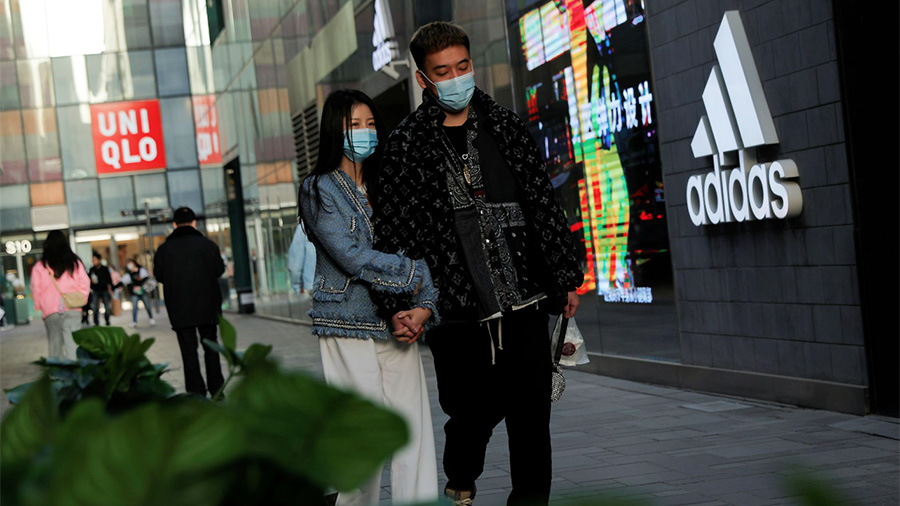Bank of America (BofA) downgraded Adidas to “Underperform” from “Neutral” due to uncertainty around China’s recovery and supply-chain issues, coupled with ongoing market share losses.
“Visibility of China’s recovery is poor as sportswear brands navigate cotton-related boycotts and a macro slowdown,” wrote Bank of America analyst David Roux in a research note. “While issues are known, we think headwinds last longer than expected.”
On China, he noted that Adidas’ greater reliance on the region as a growth drive “leaves it most exposed” compared to its peers. China made up 61 percent of Adidas’ growth from 2017 to 2019 versus a third for its peers, Nike and Puma. China also contributes 22 percent of Adidas’ revenue compared to about 15 percent for Puma and Nike.
Part of the uncertainty around China’s recovery is related to cotton-related boycotts. International brands have underperformed local brands since March 2021 due to Chinese social media calls to boycott certain Western brands in response to their stance against sourcing cotton from Xinjiang, home to many ethnic minority groups, including the Turkic Uyghur people.
The analyst said history and discussions with Topsport, Anta and a leading Nike distributor in China suggested that the direct fallout from the boycott would be short-lived; however, the boycott presented an opportunity for China’s local brands. China’s top three brands, Anta, Li Ning and 361, now have a more significant market share than Adidas, Puma and Nike on Tmall for the first time.
Roux wrote, “it remains unclear as to how competition from domestic brands will evolve. We do think that domestic brand mindshare has increased relative to international brands as a result of this years’ experience and the competitive landscape has evolved.”
BofA’s China economics team also recently reduced its GDP forecast for China due to COVID Delta Variant outbreaks, tightening credit and de-carbonization policies cutting commodity production. Recent power outages also add downside risks to China’s industrial activities and economic growth.
“Adidas China recovery expectations may be unrealistic,” stated Roux. “In light of the uncertainty around a recovery in consumer sentiment for international brands, coupled with broader macro weakness, we see a more gradual slope of recovery for Adidas’ Greater China region out to 2023E than previously expected.”
Regarding supply-chain hurdles, Roux said sportswear supply chains have been under pressure year-to-date due to strong demand, tight freight markets, and COVID disruptions.
BofA’s team recently hosted a call with an Asian sourcing expert from New Balance who estimated 100 million to 150 million pairs of sports footwear across the industry had been lost from two months of shutdown in Vietnam, and the turnaround time for product from Asia to the U.S. has been extended by at least two to three weeks. Roux noted that the challenges were affirmed by Nike’s recent results in which Nike officials pointed to losing ten weeks of production from factory shutdowns in Vietnam and transit times to the U.S. have doubled from 40 days to 80 days.
BofA reduced its estimates for Adidas revenue and gross margins to slightly below Wall Street’s consensus for the current year and are now even more off consensus for 2022 due to greater caution due to the potential impact from supply-chain issues. Roux said, “We think the full impact of product delays will start to materialize in 4Q21 and early 2022E, as lead times for products from order to shelf typically takes ten weeks. We believe the U.S. could be particularly impacted by this given the fact that it is a major end-market for Vietnam-made product.”
Finally, Roux noted that Adidas had seen slower growth versus Nike and Puma since mid-2018, and it’s been noticeable across operating regions. Analyzing Baidu and Google search data and website traffic across six global sports brands—Nike, Adidas, Puma, Reebok, Under Armour, and Asics—shows Adidas’ momentum has been persistently below Puma’s and Nike’s since the third quarter of 2019.
Wrote Roux, “While it is showing some green shoots in 3Q21 to date, we note that this is not a broad recovery as only one of the four input factors has inflected. We would prefer to see further signs of stabilization before assuming a rebound in growth versus peers.”
Photo courtesy Reuters
















